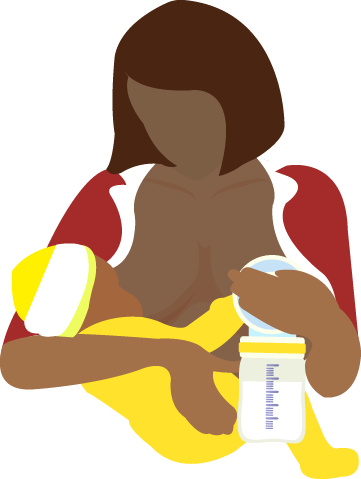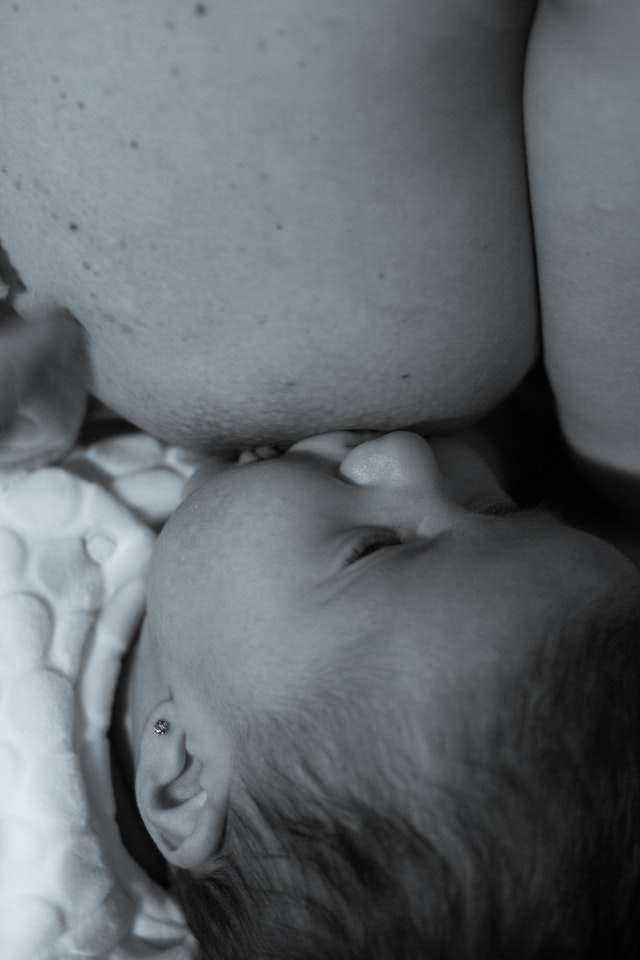Breastfeeding is something only you can do for your baby. It should be a pleasant experience for both of you. A healthy, full-term baby is likely to know instinctively what to do at the breast. In the first three to five days after birth, if you experience nipple soreness beyond a slight tenderness when your baby latches on, it may be a sign that something isn’t right with the baby’s latch, position, or suck. An adjustment to the latch or positioning can help you and your baby to be more comfortable. With proper positioning and latch-on techniques, you can expect little or no nipple soreness. Correcting poor positioning or latch-on can often alleviate sore, cracked nipples and allow healing to begin.
If nipple pain worsens after the early days of breastfeeding your nipple pain may be due to other causes like thrush, bacterial infection, or tongue-tie. Contact a doctor or lactation expert for help if you need further assistance to improve your sore nipples.
THE FIRST WEEK: POSITIONING AND LATCH-ON
Learn to recognize your baby’s early feeding cues so you have time to get in a good position and comfortable before he becomes desperately hungry. Early cues include opening his mouth and moving his head side-to-side—known as the rooting reflex—or sucking on hands or fingers. Don’t wait for baby to cry to let you know he is hungry. Crying is a very late hunger cue.
Adjusting the position can improve breastfeeding pain. If you have pain, try different positions such as laid-back, football or cradle position.
LAID-BACK POSITION
Position yourself comfortably in bed, on the couch or in a recliner with back support, pillows to also support your head, shoulders, arms. Since you’re leaning back, your baby can rest on you in any position you like.
If you are seated, support your feet with a footrest or a telephone book.
Let your baby’s whole front touch your whole front. His mouth and nose should be facing your nipple. Let your baby’s cheek rest somewhere near your bare breast.
Rub your nipple on baby’s upper lip to encourage baby to open wide. Bring your baby close. Have his chin touch your breast first, and then his nose will touch your breast.
Position baby close to you, with his hips flexed, so that he does not have to turn his head to reach your breast. Baby’s feet need to feel supported by your body so they don’t dangle in the air.
Use one hand to support your breast, if needed, and the other to support baby’s thigh or bottom.
If you are feeling pain, detach baby gently by using your finger to touch the corner of baby’s mouth and try again.
FOOTBALL POSITION
This is a good position for a mother who has had a Cesarean birth, as it keeps the baby away from the incision.
Baby’s is to your side on the same side you are breastfeeding and under your arm. Support your baby’s head in your hand and his back along your arm beside you.
Support your breast with a “C” hold.
Have baby facing the nipple, with his mouth at nipple height. Use pillows to bring the baby to the correct height.
Your baby’s legs and feet are tucked under your arm with his hips flexed and his legs resting along side your back rest so the soles of his feet are pointed toward the ceiling. (This keeps him from being able to push against your chair.)
CRADLE POSITION
Make sure you are relaxed and comfortable as your baby feeds. Lean back in your chair, supporting your back with a bed pillow turned vertically if needed. Don’t lean forward and hunch over your baby. Raise your feet off the floor, using an ottoman or even a phone book. Breathe deeply and be sure to relax and drop your shoulders.
Position your baby on his side, with his whole body facing yours and angled so his chest is securely against your abdomen. Baby should not have to turn his head to nurse.
Cradle baby in the arm on the same side as the breast he will be nursing from. If you’re breastfeeding on the right breast, baby’s head will rest on your right forearm near your elbow, his nose at the level of your nipple, and his head tilted slightly back. He is supported by your forearm with your hand holding his bottom or thigh.
Support your breast with your other hand well back from the nipple and baby’s mouth, keeping your fingers positioned either above or below or on either side of the breast.
Bring your baby to the breast. Trigger his natural response to open his mouth wide by touching his lips lightly with your nipple. Light, repeated tapping or brushing triggers a wide-open mouth.
As you bring baby to the breast with his head slightly tilted back, his chin will press into the breast first. More of your breast will be covered with his lower jaw.
Aim your nipple toward the roof of baby’s mouth and gently bring him onto the breast as he latches on.
When baby is latched well, his chin should be pressed into the breast, and his nose slightly away from it.
If you leave the hand supporting the breast in place, be sure you do not press down with your thumb, which can pull your nipple to the front of baby’s mouth. If you remove the supporting hand from your breast, make sure baby has enough head control to keep him well latched. If your breasts are large, it can be helpful to put a small rolled-up towel beneath them for support.
CROSS CRADLE POSITION
This position is a variation of the cradle position, called the cross-cradle position.
For this position, your baby is supported on a pillow across your lap to help raise him to your nipple level.
Pillows should also support both elbows so your arms don’t hold the weight of the baby; they will tire before the feeding is finished.
If you are preparing to breastfeed on the left breast, your left hand supports that breast in a “U” hold.
You support your baby with the fingers of your right hand. Do this by gently placing your hand behind your baby’s ears and neck with your thumb and index finger behind each ear.
Your baby’s neck rests in the web between the thumb, index finger and palm of your hand, forming a “second neck” for baby. The palm of your hand is placed between his shoulder blades.
As you prepare to latch on your baby, be sure his mouth is very close to your nipple from the start. When baby opens his mouth wide, you push with the palm of your hand from between the shoulder blades. His mouth will be covering at least a half-inch from the base of your nipple.
If baby is not latched on well or if it hurts, remove him from the breast by inserting your finger into the side of his mouth and try again.
Look at your nipple after breastfeeding, if it looks blanched or pinched, review the latch and positioning tips to see if you can find adjustments to make. The nipple should look the same way it did before breastfeeding, neither pinched nor blanched.
Source: La Leche Leaugue
Link: https://www.llli.org/breastfeeding-info/breastfeeding-sore-nipples/




